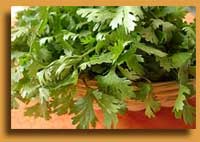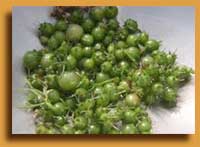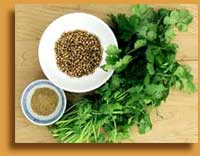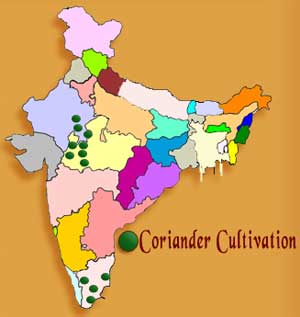CORIANDER
Introduction
Coriander which is commonly known as Dhania belongs to Apiaceae. It is largely grown in Rajasthan, Gujarat, Tamil Nadu, Madhya Pradesh, Uttar Pradesh. Mostly it is used as a condiment for its therapeutic properties as well as for the culinary supplement as a spice. The fresh green leaves from the coriander are also broadly used in the field of culinary. Coriander is a very important spice crop which has a prime position as a flavoring agent in foods. The shrub is a shrill stemmed, little, thick herb, grows up to 25-50 cm tall with numerous branches and umbels. Leaves are arranged alternately and compounded. The entire plant has a very pleasant smell. Inflorescence is a complex umbel comprising 5 smaller umbels. Fruit is globular in shape, rounds 3 to 4 mm in diameter.
When pressed it breaks into two locules with each containing one seed. The fruit has a very delicate scent. Seeds' color varies from pale white to light brown. There are two types of morphological types, one upright and lofty with a moderately stronger main shoot and the other with bushy nature and a relatively feebler main shoot and lengthier spreading branches.
Common Names
Coriandrum sativum is the scientific botanical name of the plant. In the common languages of India ie., in Hindi it is called as Dhania or Dhanya; in Bengali is called as Dhana, Dhania; in Gujarati it is called as Kothmiri, Libdhaba; in Kannada it is called as Kothambri, Kothamiri bija; in Kashmiri it is called as Deaniwal, Kothambalari; in Malayalam it is called as Kothumpalari bija; in Marathi it is called as Dhana; in Oriya it is called as Dhania; in Punjabi it is called as Dhania; in Sanskrit it is called as Dhanyaka; in Tamil it is called as Kothamalli; in Telugu it is called as Dhaniyalu.
Parts of the plant used
Leaves
The leaves are known in a lot of ways as fresh coriander, Chinese parsley, coriander leaves, or cilantro mainly in North America. Fresh coriander leaves, which are also known as Chinese parsley or cilantro should not be baffled with cilantro which is a very close family member of coriander but has a noticeably different appearance, a much more strong volatile leaf oil and a stronger aroma. The leaves have a very diverse taste from the seeds, with citrus overtones. Many acknowledge an unlikable soapy taste or a rank smell and hence avoid the leaves.
The flavors have also been compared to those of the stink bug, and similar chemical groups are involved especially in aldehydes. There appears to be a genetic component to the detection of soapy versus herby tastes.
Fruits
The dehydrated fruits are called as coriander or coriandi seeds. In India they are known as dhania. The word coriander in food training may refer exclusively to these kernels as a spice, rather than the plant. The seeds have a lemony citrus savor when crushed, due to the presence of terpenes linalool and pinene. It is illustrated as a warm, spicy, nutty and orange-flavored spice. The variety C. s. vulgare has a fruit with the diameter of 3-5 mm, while variety microcarpum fruits are found with the diameter of 1.5-3 mm.Large sized fruit types are mostly grown by tropical and subtropical countries such as India.
Morocco and Australian varieties contain a very low volatile oil content around 0.1-0.4%. They are used widely for blending and grinding purposes in the spice trade.
Uses
Cooking
Even though coriander originated from the countries of the Mediterranean Sea, the dried seeds and fresh leaves are used chiefly in Indian and Latin American cuisines. In Europe it is now back in style in the stir of the culinary cultures. Many are the culinary uses of coriander. It is not only used as a log in making some sausages, flavoring meat, fish and vegetables, but also in smelling candies, cookies and pampepato, the seed is used as a spice. There are less spicy leaves which are a bit sweet in taste with a slight lemon flavor. Grounded coriander seeds are an important constituent of curry powder and garam masala.
The leaves, in the East, are used instead of prezzemolo. A Tenerife is used in the making of Green Mojo sauce variety. In the past, in Italy, it was used in the Mortadella. In the city of Monte San Biagio, and in a few countries of the Ionian coast of Basilicata coriander seed is used as a flavoring agent in sausage mixture.
Medicine
The Ancient Greeks were said to use coriander to help in weight loss. In Ayurvedic medicine, coriander is used as a digestive support. In Chinese medicine, the entire herb is used to treat conditions such as nausea, hernias, measles, toothache, dysentery and piles. Conventionally, coriander has been used as a mixture to aid in the curing of digestive conditions, flatulence, anorexia, gripe pains and for children's diarrhea. Coriander produces an essential oil on steam distillation of the crushed seeds which are used in aromatherapy for curing.
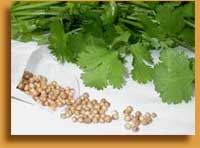
In aromatherapy use, coriander has the capability to help in the healing of digestive harms such as flatulence, indigestion and constipation, to eliminate toxins, ease migraine, stimulate circulation and treat rheumatism and arthritis. The leaves of coriander can be prepared into a tea which can also be mixed with Fennel, Caraway and Aniseed which can also help in aiding flatulence and indigestion. Breastfeeding mothers drink coriander tea to relieve colic in baby. Coriander leaves and seeds are used broadly in cooking as both a spice and garnish, chiefly in Middle Eastern cookery and in curries. Coriander is frequently added as a flavoring element in pharmaceutical digestive remedies, in perfume and to flavor liqueurs such as Chartreuse and Benedictine. Used correctly, coriander has many properties to aid in healing. It can be used as an essential oil, in natural medicine practices, such as Chinese and Ayurvedic Medicine, and drunk as a medicinal tea. Coriander has culinary purposes and flavoring properties in contemporary remedies and is used to treat digestive ailments. Overall, coriander is a multipurpose herb for healing. The cooling effects of coriander make it a brilliant remedy for urinary disorders, mainly those with hot burning symptoms such as cystitis and urethritis. Taken in as a warm decoction it helps to determine urinary tract infections quickly. The diuretic result of coriander goes some way to explain its cooling and cleansing result. One of the favorite remedies used by women for reducing menopausal heat and flushes, as an adjunct to other hormone matching herbs, is coriander water.
Coriander Cultivation in India
